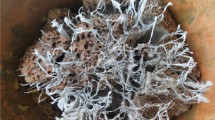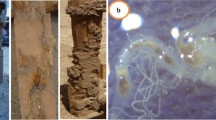Abstract
Termites are global pests and can cause serious damage to buildings, crops, and plantation forests. The symbiotic intestinal flora plays an important role in the digestion of cellulose and nitrogen in the life of termites. Termites and their symbiotic microbes in the gut form a synergistic system. These organism work together to digest lignocellulose to make the termites grow on nitrogen deficient food. In this paper, the diversity of symbiotic microorganisms in the gut of termites, including protozoan, spirochetes, actinomycetes, fungus and bacteria, and their role in the digestion of lignocellulose and also the biotechnological applications of these symbiotic microorganisms are discussed. The high efficiency lignocellulose degradation systems of symbiotic microbes in termite gut not only provided a new way of biological energy development, but also has immense prospect in the application of cellulase enzymes. In addition, the study on the symbiotic microorganisms in the gut of termites will also provide a new method for the biological control of termites by the endophytic bacteria in the gut of termites.
Similar content being viewed by others
References
Warnecke F, Luginbühl P, Ivanova N, Ghassemian M, Richardson TH, Stege JT (2007) Metagenomic and fuctional analysis of hindgut microbiota of a wood-feeding higher termite. Nature 450(7169):560–565
Eggleton P (2010) An introduction to termites: biology, taxonomy and functional morphology. In: Biology of termites: a modern synthesis. Springer, Dordrecht
Hartke TR, Baer B (2011) The mating biology of termites: a comparative review. Anim Behav 82(5):927–936
Köhler T, Dietrich C, Scheffrahn RH, Brune A (2012) High-resolution analysis of gut environment and bacterial microbiota reveals functional compartmentation of the gut in wood-feeding higher termites (Nasutitermes spp.). Appl Environ Microbiol 78(13):4691–4701
Nakashima K, Watanabe H, Saitoh H, Tokuda G, Azuma JI (2002) Dual cellulose digesting system of the wood-feeding termite, Coptotermes formosanus Shiraki. Insect Biochem Mol Biol 32:777–784
Sun LQ, Hse CY, Shupe T, Sun MJ, Wang XH, Zhao K (2015) Isolation and characterization of an endophytic fungal strain with potent anti-microbial and termicidal activities from Port-Orford-Cedar. J Econ Entomol 108(3):962–968
König H, Fröhlich J, Berchtold M, Wenzel M (2002) Diversity and microhabitats of the hindgut flora of termites. Recent Res Dev Microbiol 6:125–156
König H, Fröhlich J, Hertel H (2006) Diversity and lignocellulolytic activities of cultured microorganisms 6: 271–301
Chouvenc T, Efstathion CA, Elliott ML, Su NY (2013) Extended disease resistance emerging from the faecal nest of a subterranean termite. Proc R Soc B 280(1770):1013–1885
Hongoh Y (2011) Toward the functional analysis of uncultivable, symbiotic microorganisms in the termite gut. Cell Mol Life Sci 68(8):1311–1325
Yamin MA (2010) Axenic cultivation of the cellulolytic flagellate Trichomitopsis termopsidis (Cleveland) from the termite Zootermopsis. J Eukaryot Microbiol 25(4):535–538
Yang H, Peng JX, Liu KY, Hong HZ (2006) Diversity and function of symbiotic microbes in the gut of lower termites. Acta Microbiol Sinica 46(3):496–499
Dröge S, Fröhlich J, Radek R, König H (2006) Spirochaeta coccoides sp. nov., a novel coccoid spirochete from the hindgut of the termite Neotermes castaneus. Appl Environ Microbiol 72(1):392–397
Dröge S, Fröhlich J, Radek R, König H (2008) Treponema isopterocolens sp. nov., a novel spirochete from the hindgut of the termite Incisitermes tabogae. Int J Syst Evol Microbiol 58:1079–1083
Bi SF, Guo ZK, Jiang N, Jiao RH (2013) New alkaloid from Streptomyces koyangensis residing in Odontotermes formosanus. J Asian Nat Prod Res 15(4):422–425
Harazono K, Yamashita N, Shinzato N, Watanabe Y, Fukatsu T, Kurane R (2003) Isolation and characterization of aromatics-degrading microorganisms from the gut of the lower termite Coptotermes formosanus. Biosci Biotechnol Biochem 67(4):889–892
Gomati V, Ramasamy K, Kumar K, Sivaramaiah N, Mula R (2011) Green house gas emissions from termite ecosystem. Afr J Microbiol Res 5(2):56–64
Wenzel M, Schönig I, Berchtold M, Kämpfer P, König H (2002) Aerobic and facultatively anaerobic cellulolytic bacteria from the gut of the termite Zootermopsis angusticollis. J Appl Microbiol 92(1):32–40
Paul K, Nonoh JO, Mikulski L, Brune A (2012) “Methanoplasmatales,” thermoplasmatales-related archaea in termite guts and other environments, are the seventh order of methanogens. Appl Environ Microbiol 78(23):8245–8253
Guo C, Sun LQ, Kong D, Sun MJ, Zhao K (2014) Klebsiella variicola, a nitrogen fixing activity endophytic bacterium isolated from the gut of Odontotermes formaosanus. Afr J Microbiol Res 8(12):1322–1330
Brune A (2014) Symbiotic digestion of lignocellulose in termite guts. Nat Rev Microbiol 12(3):168–180
Strassert JF, Köhler T, Wienemann TH, Ikeda-Ohtsubo W, Faivre N (2012) ‘Candidatus Ancillula trichonymphae’, a novel lineage of endosymbiotic Actinobacteria in termite gut flagellates of the genus Trichonympha. Environ Microbiol 14(12):3259–3270
Ohkuma M, Ohtoko K, Iida T, Tokura M, Moriya S, Usami R, Horikoshi K, Kudo T (2000) Phylogenetic identification of hypermastigote, Pseudotrichonympha, Spirotrichonympha, Holomastigotoides, and parabasalian symbionts in the hindgut of termites. J Eukaryot Microbiol 47(3):249–259
Hongoh Y, Ohkuma M, Kudo T (2003) Molecular analysis of bacterial microbiota in the gut of the termite Reticulitermes speratus (Isoptera; Rhinotermitidae). Fems Microbiol Ecol 44(2):231–242
Petersona BF, Stewart HL, Scharf ME (2015) Quantification of symbiotic contributions to lower termite lignocellulose digestion using antimicrobial treatments. Insect Biochem Mol Biol 59:80–88
Graber JR, Leadbetter JR, Breznak JA (2004) Description of Treponema. Azotonutricium sp. nov. and Treponema Primitia sp. nov., the first spirochetes isolated from termite guts. Appl Environ Microbiol 70:1315–1320
Leadbetter JR, Schmidt TM, Graber JR, Breznak JA (1999) Acetogensis from H2 plus CO2 by spirochetes from termite guts. Science 283:686–689
Berlanga M, Paster BJ, Guerrero R (2007) Co-evolution of symbiotic spirochete diversity in lower termites. Int Microbiol 10(2):133–139
Sujada N, Sungthong R, Lumyong S (2014) Termite nests as an abundant source of cultivable antibacteria for biotechnological purpose. Microbes Environ 29(2):211–219
Lefebvre T, Miambi E, Pando A, Diouf M, Rouland-Lefèvre C (2009) Gut-specific actinobacterial community structure and diversity associated with the wood-feeding termite species, nasutitermes corniger, (motschulsky) described by nested pcr-dgge analysis. Insect Soc 56(3):269–276
Fall S, Hamelin J, Ndiaye F, Assigbetse K, Aragno M, Chotte JL (2007) Differences between bacterial communities in the gut of a soil-feeding termite (Cubitermes niokoloensis) and its mounds. Appl Environ Microbiol 73(16):5199
Berchtold M, Chatzinotas A, Schönhuber W, Brune A, Amann R, Hahn D, König H (1999) Differential enumeration and in situ localization of microorganisms in the hindgut of the lower termite Mastotermes darwiniensis. Arch Microbiol 172(6):407–416
Hethener P, Brauman A, Garcia JL (1992) Clostridium termitidis sp. nov., a cellulolytic bacterium from the gut of the wood-feeding termite, Nasutitermes lujae. Syst Appl Microbiol 15(1):52–58
Tokuda G, Watanabe H (2007) Hidden cellulases in termites: revision of an old hypothesis. Biol Lett 3(3):336–339
Shinzato N, Muramatsu M, Matsui T, Watanabe Y (2007) Phylogenetic analysis of the gut bacterial microflora of the fungus-growing termite Odontotermes formosanus. Biosci Biotechnol Biochem 71(4):906–915
Bauer S, Tholen A, Overmann J, Brune A (2000) Characterzation of abundance and diversity of lactic acid bacteria in the hindgut of wood- and soil-feeding termites by molecular and culture-dependent techniques. Arch Microbiol 173(2):126–137
Leadbetter JR, Crosby LD, Breznak JA (1998) Methanobrevibacter Filiformis sp. nov., a filamentous methanogen from termite hindguts. Arch Microbiol 169(4):287–292
Veivers PC, Mühlemann R, Slaytor M, Leuthold RH, Bignell DE (1991) Digestion, diet and polyethism in two fungus-growing termites: Macrotermes subhyalinus Rambur and M. michaelseni Sjøstedt. J Insect Physiol 37(9):675–682
Zhao K, Liu J, Li ZG, Chang ZW, Shi PF, Ping WX, Zhou DP (2011) Bacillus subtilis subspecies virginiana, a new subspecies of antitermitic compound-producing endophytic bacteria isolated from uniperus virginiana. J Econ Entomol 104(5):1502–1508
Deng T, Zhou Y, Cheng M, Pan C, Chen C, Mo J (2008) Synergistic activities of the symbiotic fungus termitomyces albuminosus on the cellulase of odontotermes formosanus (Isoptera: termitidae). Sociobiology 51(3):733–740
Tokuda G, Watanabe H, Hojo M, Fujita A, Makiya H, Arakawa G, Arioka M (2012) Cellulolytic enviroment in the midgut of the wood-feeding higher termite Nasutitermes takasagoensis. J Insect Physiol 58(1):147–154
Wu T, Kong D, Sun LQ, Guo C, Sun MJ, Zhao K (2014) Identification of a nitrogen fixation endophyte from Odontotermes formosanus. J Pure Appl Microbiol 8(2):1669–1674
Tokuda G, Lo N, Watanabe H (2005) Marked variations in patterns of cellulase activity against crystalline vs. carboxymethyl-cellulose in the digestive systems of diverse, wood-feeding termites. Physiol Entomol 30(4):372–380
Bakalidou A, Kämpfer P, Berchtold M, Kuhnigk T, Wenzel M, König H (2002) Cellulosimicrobium variabile sp. nov., a cellulolytic bacterium from the hindgut of the termite Mastotermes darwiniensis. Int J Syst Evol Microbiol 52(4):1185–1192
Tai V, James ER, Nalepa CA, Scheffrahn RH, Perlman SJ, Keeling PJ (2015) The role of host phylogeny varies in shaping microbial diversity in the hindguts of lower termites. Appl Environ Microbiol 81(3):1059–1070
Arakawa G, Watanabe H, Yamasaki H, Maekawa H, Tokuda G (2009) Purification and molecular cloning of xylanases from the wood-feeding termite, C. formosanus Shiraki. Biosci Biotechnol Biochem 73:710–718
Pester M, Brune A (2007) Hydrogen is the central free intermediate during lignocellulose degradation by termite gut symbionts. Isme J 1(6):551–565
Konig H, Li L, Fröhlich J (2013) The cellulolytic system of the termite gut. Appl Microbiol Biotechnol 97(18):7943–7962
Cleveland LR (1925) The method by which Trichonympha campanula, a protozoön in the intestine of termites, ingests solid particles of wood for food. Biol Bull 48(4):282–288
Hungate RE (1941) Experiments on the nitrogen economy of termites. Ann Entomol Soc Am 34(2):467–489
Benemann JR (1973) Nitrogen fixation in termites. Science 181(4095):164–165
Breznak JA, Brill WJ, MertinsJ W, Coppel HC (1973) Nitrogen fixation in termites. Nature 244(5418):577–580
Yamada A, Inoue T, Wiwatwitaya D, Ohkuma M, Kudo T, Sugimoto A (2006) Nitrogen fixation by termites in tropical forests, Thailand. Ecosystems 9(1):75–83
Meuti ME, Jones SC, Curtis AS (2010) 5N Discrimination and the sensitivity of nitrogen fixation to changes in dietary nitrogen in Reticulitermes flavipes (Isoptera: Rhinotermitidae). Environ Entomol 39(6):1810–1815
Scharf ME, Karl ZJ, Sethi A (2011) Defining host-symbiont collaboration in termite lignocellulose digestion: “The view from the tip of the iceberg”. Commun Integr Biol 4(6):761–763
Castro AM, Pereira N Jr (2010) Production, properties and application of cellulases in the hydrolysis of agroindustrial residues. Quim Nova 33(1):181–188
Sun J, Zhou XJ (2011) Utilization of lignocellulose-feeding insects for viable biofuels: an emerging and promising area of entomological science. In: Recent advances in entomological research. Springer, Berlin Heidelberg, pp 434–500
Sun JZ, Chen CR (2010) Cellulolytic insects and their potentials for viable biofuels: a new frontier discipline in entomology and bioengineering. Chin Bull Entomol 47(6):1033–1042
Singh A, Olsen SI (2011) A critical review of biochemical conversion, sustainability and life cycle assessment of algal biofuels. Appl Energy 88(10):3548–3555
Liu J, Cao D, Zhao K, Ping WX, Zhou DP (2008) Separating endophytes from Port-Orford-Cedar. J Sci Teachers' Coll Univ 4:62–64
Acknowledgements
This work was supported in part by the Technological innovation talent of special funds for outstanding subject leaders in Harbin (2014RFXXJ081) and Special Project of Graduate Entrepreneurship of Heilongjiang University (20170160908).
Author information
Authors and Affiliations
Corresponding authors
Ethics declarations
Conflict of interest
The authors declare no conflicts of interest in this work.
Rights and permissions
About this article
Cite this article
Zhou, J., Duan, J., Gao, M. et al. Diversity, Roles, and Biotechnological Applications of Symbiotic Microorganisms in the Gut of Termite. Curr Microbiol 76, 755–761 (2019). https://doi.org/10.1007/s00284-018-1502-4
Received:
Accepted:
Published:
Issue Date:
DOI: https://doi.org/10.1007/s00284-018-1502-4




